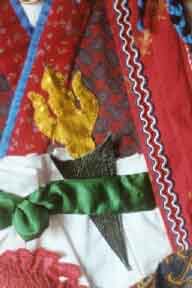
The Phurba
Yeshé Tsogyel Appliqué 2003
Tantric yogis and yoginis wear vajra weapons in the belt of their shamthab. Vajra weapons are the means of effecting the Tantric path of transformation. This is also connected with warriorship. A tantrika lives on the brink of death. A tantrika dwells in the lived reality of the death of every moment.
Khandro Déchen comments:
Lamas of the gö-kar chang-lo’i dé are often portrayed wearing a phurba in the belt. One can see examples of this with Jomo Pema ’ö-Zér, ’a-Shul Pema Legden, A-Kyong Düd’dül Dorje, and Aro Yeshé. To wear a phurba in one’s belt is characteristic of the ngakpa and ngakma. The mantra-wielding community
– the ngak’phang sangha
– are customarily peaceful warriors, Vajrayana practitioners who
are prepared at any moment to annihilate their dualistic clinging. Nuden Dorje Dro’phang Lingpa Tröllö-tsal’s belt is green – as is the robe of his phurba. Green is the colour of activity, and phurbas are mainly ‘dressed’ in green robes. When not in use the phurba is wrapped so the face of Dorje Phurba cannot be seen.
Ngak’chang Rinpoche comments:
Dorje Phurba is the yidam who transforms anger into clarity. The ngak’phang yogi or yogini is not spiritually anxious of his or her emotions. Ngakpas and ngakmas who succeed in maintaining their vows know that their emotions are the display of the primordial state, and as such simply need to be liberated into their natural condition. To wield the phurba is to proclaim that the death of one’s illusions is an ever present possibility. The ngak’phang yogi or yogini lives on the razor edge of the power invested in this radical symbol of liberation.
The phurba in the Yeshé Tsogyel appliqué is made of leather with a golden fabric top, and is tucked into her green silk belt.
